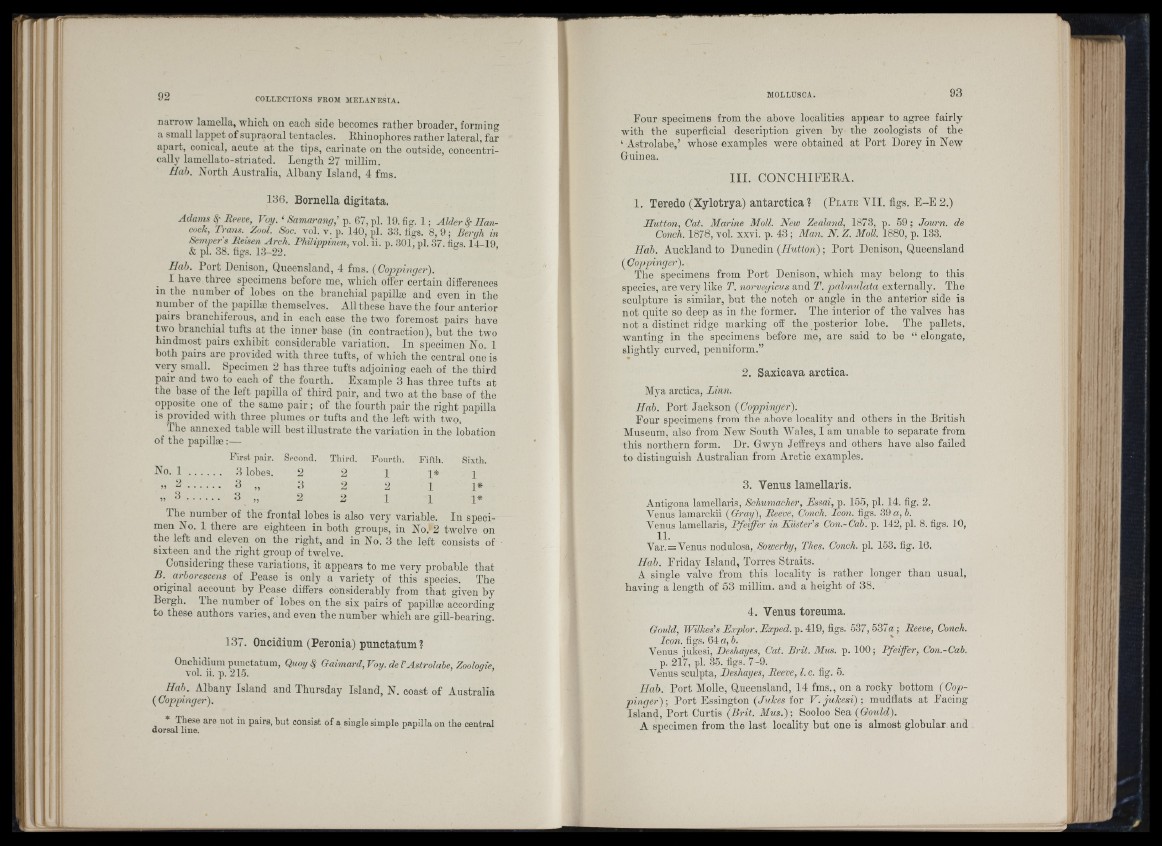
í ii 'f.
narrow lamella, which on each side becomes rather broader, forming
a small lappet of supraoral tentacles. Phinophores rather lateral, far
apart, conical, acute at the tips, carinate on the outside, concentrically
lamellato-stnated. Length 27 millim.
Hah. North Australia, Albany Island, 4 fms.
136. Bornella digitata.
Adams f Reeve, Voy. ‘ Samarang,' p. 67, pi. 19. fig. 1; Alder ^ Hancock,
Trans. Zool. Soc. vol. v. p. 140, pi. 33. figs. 8, 9; Bergh in
Semper s Reisen Arch. Bhilippinen, vol. li. p. 301, pi. 37 fio-s 14-19
& pi. 38. tigs. 1.3-22. F
Hah. Port Denison, Queensland, 4 fms. (Coqypinger).
I have three sjiecimens before me, which offer certain differences
in the number of lobes on the branchial papilhe and even in the
number of the papilla? themselves. All these have the four anterior
pairs branchiferous, and in each case the two foremost pairs have
two branchial tufts at the inner base (in contraction), hut the two
hindmost jiairs exhibit considerable variation. In specimen No. 1
both pairs are provided with three tufts, of which the central one is
very small. Specimen 2 has three tufts adjoining each of the third
pair and two to each of the fourth. Example 3 has three tufts at
the base of the left papilla of third pair, and two at the base of the
opposite one of the same p a ir ; of the fourth pair the right papilla
is provided with three plumes or tufts and the left with two.
The annexed table will best illustrate the variation in the lobation
of the papilla?;—
First pair.
No. 1 ............ 3 lobes.
” 2 «‘IJ 11
„ 3 ........... 3 ..
Spcond.
2
3
Third.
2
2
9
Fourth.
121 Fiftli.
1*
1
1
Sixth.
1
1*
1*
The number of the frontal lobes is also very variable. In specimen
No. 1 there are eighteen in both groups, in No. 2 twelve on
the left and eleven on the right, and in No. 3 the left consists of
sixteen and the right group of twelve.
Considering these variations, it appears to me very probable that
B. arborcscens of Pease is only a variety of this species. The
original account by Pease differs considerably from th a t given by
Bergh. The number o f ' lobes on the six pairs of papilla? according
to these authors varies, and even the number which are gill-bearing.
137. Oncidium (Peronia) pnnctatnm ?
Onchidium puiictatum, Quoy 4 Gaimard, Voy. de VAstrolabe, Zoolonie,
vol. ii. p. 215. ’
Hah. Albany Island and Thursday Island, N. coast of Australia
(Coppinger).
* These are not in pairs, but consist of a single simple papilla on the central
dorsal line.
Four specimens from the above localities appear to agree fairly
with the superficial description given by the zoologists of the
‘ Astrolabe,’ whose examples were obtained at Port Dorey in New
Guinea.
I I I . C O N C H IF E R A .
1. Teredo (Xylotrya) antárctica ? ( P l a t e A’II. figs. E -E 2.)
Hutton, Cat. Marine Moll. New Zealand, 1873, p. 59; Journ. de
Conch. 1878, vol. xxvi. p. 43; Man. N. Z. Moll. 1880, p. 133.
Hah. Auckland to Dunedin (Hutton) ; Port Denison, Queensland
(Coppinger).
The specimens from Port Denison, which may belong to this
species, are very like T. norvegicus and T. pahnulata externally. The
sculpture is similar, but the notch or angle in the anterior side is
not quite so deep as in the former. The interior of tho valves has
not a distinct ridge marking off the posterior lobe. The pallets,
wanting in the specimens before me, are said to bo “ elongate,
slightly curved, penniform.”
2. Saxicava arctica.
Mya arctica, Linn.
Hah. Port Jackson (Coppinger).
Four specimens from the above locality and others in the British
Museum, also from New South AYales, I am unable to separate from
this northern form. Dr. Gwyn Jeffreys and others have also failed
to distinguish Australian from Arctic examples.
3. Venus lamellaris.
Antigona lamellaris, Schumacher, Essai, p. 155, pi. 14. fig. 2.
Ytenus lamarckii (Gray), Beeve, Conch. Icon. figs. 39 a, b.
A’eniis lamellaris, Pfeiffer in Küster's Con.-Cah. p. 142, pi. 8. figs. 10,
11.
Var.^APnus nodulosa, Soiverby, Thes. Conch, pi. 153. fig. 16.
Hab. Friday Island, Torres Straits.
A single valve from this locality is rather longer than usual,
having a length of 53 millim. and a height of 38.
4. Venus toreuma.
Gould, Wilkes's Explor. E x p e d . 537,537«; Reeve, Conch.
Icon. figs. 64 a,b.
Venus jukesi, Deshayes, Cat. Brit. Mus. p. 100; Pfeiffer, Con.-Cah.
p. 217, pi. 35. figs. 7-9.
Venus sculpta, Deshayes, Reeve, I. c. fig. 5.
Hah. Port Molle, Queensland, 14 fms., on a rocky bottom (Cop-
pinqer); Port Essington (Juices ior V. jukesi)-, mudflats at Facing
Island, Port Curtis (Brit. Mus.); Sooloo Sea (Gould).
A specimen from the last locality but one is almost globular and
!
Il>